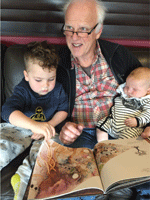Book review
Microbiology Australia 40(3) 151-151 https://doi.org/10.1071/MA19042
Published: 16 September 2019
Nema and the Xenos. A Story of Soil Cycles

|
Ailsa Wild, Aviva Reed, Briony Barr and Gregory Crocetti in collaboration with S Patricia Stock
CSIRO Publishing, 2019
What goes on in the below-ground ecosystem of a tree? Many of the answers are revealed in this stimulating book, targeted to audiences that include the very young. My review included a ‘field test’ on my 4-year-old grandson, Isaiah. He was highly attracted to the story and wants me to read it each time I see him now.
The story commences with the attack on a tree’s roots by a grub. Chemical ‘pain’ signals released by the tree attract nematodes who make a perilous underground journey, with one nematode being lassoed by lasso fungi. So impressed by this, Isaiah now involves the lasso fungi in games with his kinder playmates. The main nematode, Nema, survives carrying its cargo of Xenos (xeno bacteria) on the journey to the grub. Along the way there are many other lifeforms in the soil including a worm, algae (surviving close to the soil surface), tardigrade (water bear), white fungus and soil bacteria. The stockpile of chemical weapons is shown, including their structures. Reaching the grub, the xenos are released to feast on the grub, which then become the nematode feast. The life cycle continues.
This 33-page story could be appreciated by anyone with a fascination for living systems, and from Isaiah’s response is an excellent introduction to microbial ecology.
Following the story is a 16-page resource section that shows pictures of the actual story characters, as well as others that live in soil. The size differences are highlighted with examples including larger soil animals (moles, ants, earthworms etc.) to smaller soil animals (e.g. nematodes, mites, tardigrades etc.) to the microscopic life (e.g. protozoa, fungi, algae, bacteria etc.). This book follows two others in the series: Zobi and the Zoox; A Story of Coral Bleaching and The Squid, The Vibrio & The Moon. The book is well illustrated and would be very useful in the classroom, including in early primary education, stimulating early awareness of the interactions and diversity of life. I think it has given my 4-year-old grandson an unusual (for his age) introduction and awareness of microbial ecology. Thanks to all those involved in creating this book, including ASM. It is a great resource to our kids and may encourage them to pursue microbiology, or at least to think more about how microbes contribute to life’s intricate ecosystems.

|
Professor Ian Macreadie
School of Science
RMIT University
Melbourne, Australia


